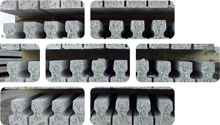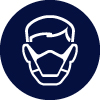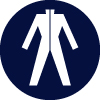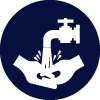
Precast Concrete Products Inert 17 01 01
Precast concrete products are inert and manufactured from cement, water, aggregate, admixture and reinforcement to suit a range of structural and non-structural uses. They are categorised into seven sub-groups - Dense and lightweight aggregate blocks, Autoclaved aerated concrete, Paving blocks and flags, Concrete roof tiles, Structural precast concrete products, Concrete pipes and Concrete flooring. Precast concrete products are cast, foamed or formed in various types, shapes and thicknesses, depending on the specification required. They are of varying quality, strength and finish depending on the desired function and performance. Some are coloured to suit the architectural finish.
Usage & Probable Locations
Precast concrete products have many uses in construction, as they are easily fitted to concrete and steel main frames or be constructed into almost any shape or form. They are commonly used in a structural capacity that include beams, columns, stairs, floors, roofs, walls, panels, cladding and retaining walls. Smaller items, slates and blocks are used to build mostly non-structural roofs, walls, floors, culverts, pipelines, pavements and infill between columns in order to close or separate spaces. Some will have an architectural finish or polish and some may incorporate an external cladding.
Personal Protective Equipment
PPE requirements indicated are for guidance purposes only. DRIDS has identified the PPE that is mandatory on all demolition projects and ones that may be required subject to site specific Risk Assessment & Method Statement (RAMS). Hover over the icon to determine the types of PPE required for the removal of this material.
Removal, Segregation & Storage
Precast concrete products such as tiles, flags, flooring and blocks that are destined for reuse should be deconstructed, segregated and stored carefully and safely, to ensure their integrity and good condition. They should be stored on pallets, strapped and shrink-wrapped to prevent breakage and splash-damage. Most precast floor beams and structural beams are pre-stressed which in larger beams will have stored energy that must be released carefully. Precast concrete products are commonly crushed for recycling and should have the majority of contaminants, fixtures and reinforcement removed to suit the quality protocol for recycled aggregates. Precast concrete walls, floors, columns, panels, cladding and retaining walls should be demolished using suitable plant and attachments and stored in piles along with other crushed materials such as bricks and concrete that have been screened. There is no need to store crushed concrete products inside a building or under cover.
Tools
Fixtures, Fittings & Connections
Precast concrete products have been traditionally fixed in place using mortar, grout, screed, bitumen and adhesives to bind the blocks, flags, pipes, culverts, connections and reinforcing bars together. Precast products are cast, formed or foamed at a factory, then fixed into position with other concrete, steel or timber products. Some precast concrete products incorporate reinforcing bars to knit with the main frame formwork or cleats, brackets, studs and holes to fix to a steel main frame or concrete face. Concrete roof tiles will be fixed in place with nails or other mechanical fixtures. Blocks, flags and pipes require no fixings and are laid in place using mortar, thin-joint grout or other binding agent. Some products are coated with bitumen in harsh environments such as farms, sewage works and water environments. Structural products will sometimes be coated in fire retardant paints or lined with fire resistant materials. Some products may also incorporate or be bonded to ins
Health & Safety
Subject to task-specific Risk Assessment & Method Statement (RAMS). Wear gloves and respiratory protective equipment (where necessary) when handling precast concrete products, crushed materials, fire retardant materials or paints to prevent irritation, cuts and abrasion. Use eye protection when using hand tools. Limit hand, arm and whole body vibration when using air tools. Only use harness protection at height as a last resort. Only use 360 plant and attachments, loaders, muck shifters, crushers, screeners or cranes if appropriately trained.
















